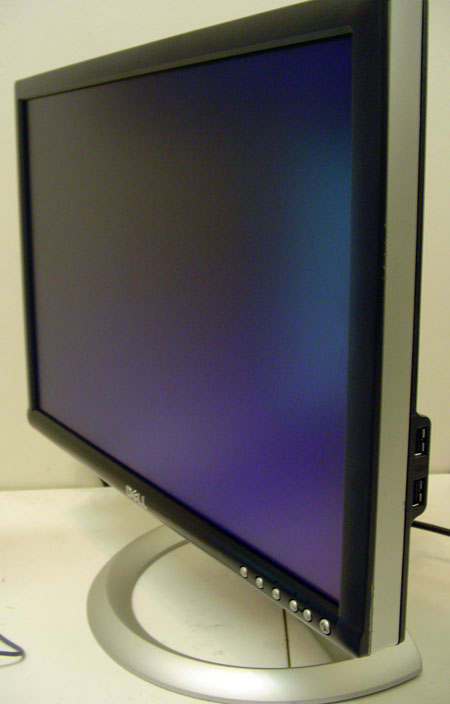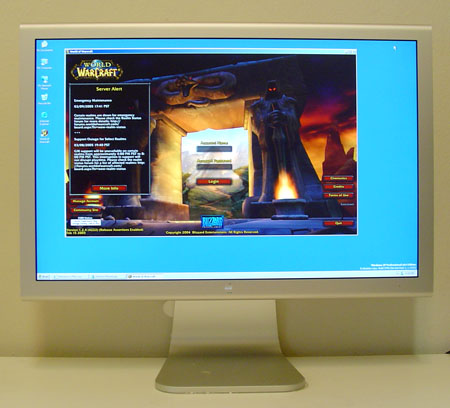The 20" LCD Shootout: Dell versus Apple
by Kristopher Kubicki on April 27, 2005 12:05 AM EST- Posted in
- Displays
Specifications
Although both the Apple and Dell 20" displays use the same LG.Philips LCD LM201W01 panel, Apple and Dell seem to differ (at least in terms of marketing) on several specifications including response time, contrast ratio and brightness. Granted, Dell and Apple use different backlights that may account for the 50 nit difference. On the other hand, Apple hardware is traditionally listed with slightly conservative specifications. Part of our review process is to evaluate these specifications anyway - and since these are nearly identical displays, it will be very easy for us to verify which model has the more accurate listed specifications.| Apple Cinema Display 20" M9177LL | |
| LCD Panel | 20.1" WSXGA+ LCD (Active Matrix) pixel pitch: 0.258mm Anti-glare coating Super IPS Panel |
| Advertised Scanning Frequency | Horizontal: 31-83kHz Vertical: 56-75Hz |
| Advertised Response Time | 16ms (Typical) |
| Advertised Viewing Angle | 170 / 170 (Horizontal / Vertical) |
| Advertised Contrast Ratio | 400:1 (Typical) |
| Compatibility | 1680 x 1050 (Native) |
| Advertised Brightness | 250 cd/m2 |
| Warranty | 1 year parts and labor |

| Dell UltraSharp 2005FPW | |
| LCD Panel | 20.1" WSXGA+ LCD (Active Matrix) pixel pitch: 0.258mm Anti-glare coating Super IPS Panel |
| Advertised Scanning Frequency | Horizontal: 31-83kHz Vertical: 56-75Hz |
| Advertised Response Time | 12ms (Typical) |
| Advertised Viewing Angle | 176 / 176 (Horizontal / Vertical) |
| Advertised Contrast Ratio | 600:1 (Typical) |
| Compatibility | 1680 x 1050 (Native) |
| Advertised Brightness | 300 cd/m2 |
| Warranty | 3 years parts and labor |
Oddly, Dell lists their 2005FPW with a typical response time of 12ms while Apple and the panel manufacturer both claim a 16ms response time. Over the last several months, we have seen display manufacturers claim only the rising response time on their product specifications. Given the track record of most manufacturers to inflate contrast ratios using favorable testing techniques, the likelihood that accurate response time measurements are starting to crumble to more aggressive marketing seems high. Of course, anyone who reads our display reviews on a regular basis can probably tell you that "average" (TrTf) response time has very little to actual responsiveness of the display and that other specifications, like color depth and display mode, can be more helpful when purchasing a new monitor.
The M9177LL utilizes very different native resolution than what we have seen in the past. LG.Philips LCD largely pioneered the WSXGA+ signal resolution found on the Cinema display and we saw our first demonstrations of the technology back at the Consumer Electronics Show in January of 2004. Since then, WSXGA+ has gained a bit of popularity in laptops, but not in LCD TVs. Unfortunately with HD signals broadcast at 1280x720 or 1920x1080, all of the XGA+ signals pioneered by LG.Philips require some signal conversions, which result in skewed pixels or skewed signals. While watching WMV9 samples on our Cinema display, we attempted to overcome this by only viewing windowed 720p movies, but unfortunately, a bit of screen real estate is wasted in the process. We can't penalize Apple or Dell for trying, however, and both the 23" and 30" Cinema displays incorporate resolutions large enough to play unaltered 1080p signals.
The strongest aspect of the LG.Philips LCD panel utilized in the Cinema display is ultimately the 8-bit Super IPS display. We have covered some displays in the past that utilize 16ms and 12ms 6-bit TN displays. We have never been in favor of sacrificing color depth for response time, but some insist that the sub 20ms response time is absolutely critical to their usage. We will get more into various usage benchmarks later on.
For those not familiar with LCD display modes and how they work, feel free to check out our LCD FAQ from 18 months ago. To reiterate, the fundamental problem with any LCD is that when the LCD liquid crystals "twist" (or "untwist"), there is ultimately a several millisecond delay. This delay translates into a several millisecond delay on the LCD screen. This is unfortunately complicated by the fact that displays do not simply twist the crystal on or off, but at one of 255 degrees (for 8-bit displays) or 63 degrees (for 6-bit displays). Obviously, two states that are very close to each other take less time than two states further apart from each other, which results in pixels that are not just delayed in a uniform manner, but at several different speeds across the entire panel depending on the hue. This generates motion blur, but is commonly misnamed as ghosting (which is a different problem that we will talk about later).
Super IPS counters motion blur by simply aligning the individual fibers that make up the crystal in a particularly easy alignment, without sacrificing viewing angle. Please refer to the FAQ if you would like to know more about SIPS in particular and how it stacks up against PVA, MVA or TN.
We were very surprised to learn that the Apple Cinema 20" display only comes with a one-year limited warranty, if you do not purchase the display with a PowerBook or PowerMac. Dell displays all come with a three-year limited warranty.











70 Comments
View All Comments
intellon - Wednesday, April 27, 2005 - link
Oh why oh why did you leave out a small paragraph of comment on the composite input or the s-video one... If you can update the review by connecting xbox to it and playing halo on the xbox, and commenting on the playability in just one itsy bitsy paragraph that would make this head to head review complete...Lots of students with cramped space dream about using computer monitor as a display for their consoles.
jasonsRX7 - Wednesday, April 27, 2005 - link
Lots of Mac users love the Dell widescreen displays, they're great for the money. I'm a Mac user and I thought a lot about getting a Dell widescreen but ended up with a 30" Apple Cinema display instead. There are tons of people in the Mac forums I visit that use the Dell 20" and 24" monitors, though.Chuckles - Wednesday, April 27, 2005 - link
Hey #11: Try $799.http://store.apple.com/1-800-MY-APPLE/WebObjects/A...
#13:
As long as your video card has the S-Video Port between the DVI ports, two connectors will fit. If they are crammed next to each other, they won't.
xsilver - Wednesday, April 27, 2005 - link
"The largest mistake that we see people make when they buy a new LCD is to put their new, bright LCD in a dim, dark room (and then turn the LCD down to 25% brightness). Not only is this terrible for your eyes,"can you clarify this? why is this so bad? you mention colour offset, but if this is changed accordingly, what is different?
lebe0024 - Wednesday, April 27, 2005 - link
This has nothing to do with MAC vs. PC. This is a display manufactured by Apple, which has nothing to do with Apple's "Macintosh" computer line, other than the fact that they're sold together.MIDIman - Wednesday, April 27, 2005 - link
An absolutely superb real down to earth mac vs. pc comparison.Reminds me of the millions of times I've been confronted by mac-lovers saying that the Apple Cinema Display is the only good LCD on the market and is "worth" the extra cost. Nowadays, I just send them to anandtech!
hirschma - Wednesday, April 27, 2005 - link
A couple of quick comments:* I have two OLD Apple DVI monitors hooked to my PC. While they work great, there is no software for the PC to control anything except the backlight controls, like the model reviewed here. I'm guessing that the new model still doesn't come with anything in that regard.
* The Apple DVI cable head looks too "fat" to use with Dual DVI cards - looks like one port will be partially blocked. Is that accurate?
I'd like to have heard more about the Apple monitor's suitability for use with Windows.
JH
cHodAXUK - Wednesday, April 27, 2005 - link
Dell UK are charging nearly £600 for the 2005, thats $1000 the cheeky mofos. Looks like Dell are another company exploiting the ripoff Britian mentality.DCstewieG - Wednesday, April 27, 2005 - link
I'm surprised the price of the Apple display is never mentioned. If the Dell is $486 at the outlet store online you figure the Apple name will cost maybe $100 or so more? So about $600.Try $999.
Geez, I think that thing is as sexy as anyone else, but holy crap is that a premium. And without the possibility of analog! $350 for the Dell on the right day makes a hell of a lot more sense to me, even if roles were reversed and it had been rated slightly worse than the Apple.
DeanO - Wednesday, April 27, 2005 - link
Good review Kristopher :)Personally, I've seen photos that show some serious backlight leakage on these things, so I'm still a little hesitant, though it's reassuring that you guys haven't had this problem.
Hope the upcoming reviews of bigger screens include the Dell 2405FPW. That screen looks fantastic!